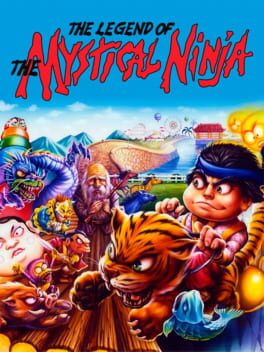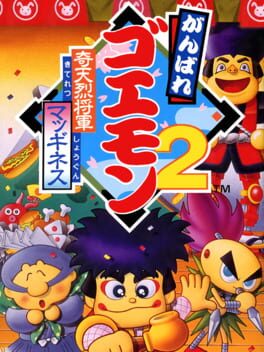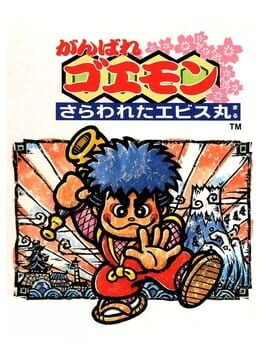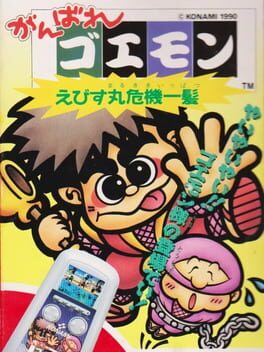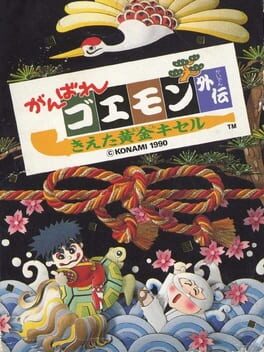

The Legend of the Mystical Ninja is a light-hearted action-adventure game for 1-2 players by Konami, and was released for the Super Nintendo Entertainment System in 1991. It is the first game in the Japanese video game series Ganbare Goemon to have a western release.
Also in series
Released on
Genres
Reviews View More
The Legend of the Mystical Ninja is a charming and wacky SNES classic! Its mix of beat 'em up action, side-scrolling platforming, and absolutely off-the-wall Japanese humor make it stand out. The mini-games are a blast, especially with a friend in co-op mode. It's on the shorter side and some of the platforming can get frustratingly difficult, but if you're into retro games and quirky adventures, this one's a gem.
For a first entry this sure left a sour taste in my mouth, great presentation and very fun style, even better when you play the translation but good god if it isn't a mess of a game, weird hitbox (for both you and the enemies) sessions where you have to grind to progress (within a time limit mind you), at some point i ran out of time cuz i had to grind coin to progress and ended up having to re-do the entire level despite being 1 hit away from killing the boss.
may the blockbuster era of games die and be only remembered for its style and fun moments, because not everything was gold as everyone seems to say the last boss surprisingly is the easiest of all, you can just get in a corner and cheese him to death, so its both unfair and anticlimatically easy at the same time
may the blockbuster era of games die and be only remembered for its style and fun moments, because not everything was gold as everyone seems to say the last boss surprisingly is the easiest of all, you can just get in a corner and cheese him to death, so its both unfair and anticlimatically easy at the same time
This is a game I owned as a kid on Wii Virtual Console, and I never got too far in it. I gave a good ol' try to get through it last year, but I got stuck on the final boss. I beat the 4th SFC Ganbare Goemon game on the actual hardware years ago and loved it, and this is one I've always wanted to see to completion before venturing on to the other two mainline 16-bit titles. After playing through one of the N64 games a week before, I decided to give this one another shot but this time on my SFC Mini instead of on the Wii VC, so I had the power of save states on my side this time XD. I actually managed to fare pretty well, and I even managed to beat the final boss in just two attempts (and I beat the second attempt taking only one hit the whole time, much to my own surprise).It took around three hours to beat the Japanese version of the game with some limited save state uses to save time re-grinding through certain objectives.
Mystical Ninja is the localization of the third mainline game in the Ganbare Goemon series, and the first 16-bit incarnation of the series as well. Goemon and his very effeminate friend Ebisumaru (localized as Kid Ying and Dr. Yang) are a pair of ninja based on the great thief Goemon of Japanese myth, but here he's just a wacky character effectively out of a gag anime. As is the case with the rest of the series, you travel around Japan to save the country (in this case, Princess Yuki and her father, the emperor) in an adventure full of anachronisms, risque humor, and a tone with the aesthetic trappings of feudal Japan but the tone of a gag anime. There isn't a ton of dialogue in this one, as this is much more of an action game than an adventure game (unlike later games in the series), but what is there is silly in an overall inoffensive way (which is more than I can say for later games in the series ^^;).
The gameplay is largely a refinement of the Famicom games, and they're for the most part sorely needed refinements. Both Goemon and Ebisimaru can go on these adventures (continuing a co-op tradition started in the Famicom games), and there are two different kinds of gameplay: town sections and platforming segments. The town sections are a sort of top-down view where you go around usually just looking for the entrance to the platforming segment where the boss awaits you, but sometimes you'll need to get money for a gate pass or some other key item. Only the last stage really has much of a puzzle element to its town segment, and it's mostly there to give you an opportunity to not only earn but spend money on things like armor, health, and extra lives. There is overall a lot less grinding in these sections than the Famicom games, and the villagers within them have responses ranging from just silly to helpful information on where to go next (although in most cases, just wandering around will get you where you need to go eventually). The hit detection on enemies and yourself in these areas is a bit awkward, some stages lack armor/health shops simply for the sake of being mean to you, and they definitely get a bit too punishing later in the game as far as enemy range goes, but they're a net neutral for the game, in my book.
The platforming sections are where the game shines a lot stronger for me. Each of the game's nine stages has one of these with a boss at the end, and it's Konami's 16-bit days at their finest. Jumping and hit detection feel way better than they do in the town sections, and the level design never has any nonsense with leaps of faith. You can use your money as projectiles or use your melee weapon to fight stuff, and you can power up your melee weapon Castlevania-style by finding lucky cats from defeated enemies. Though sadly, unlike most Castlevania games, your weapon power goes down when you get hit (continuing a tradition from the Famicom games).
This isn't the hardest 16-bit Konami game, for sure, but it ain't no slouch. Unless you can find the hidden golden lucky cats to increase your health bar (and those health bonuses go away when you beat a stage), you're generally only 4 or 5 hits away from death. You can mitigate this during the town segments by buying food to revive you upon death or armor to take more hits for you, but those are only gonna be useful for one life. The game has a pretty fair and reasonable difficulty curve until about stage 6 or 7, where it throws the kid-gloves off and starts barely even giving you shops to go to. That said, the bosses are all well designed with most of them having reasonable tells for when they're gonna do their attacks (the kabuki boss is awful and I hate him though XP). I suppose sticking to Goemon's origins as a legendary bandit, it's sometimes better to run by enemies than actually fight them, especially if you wanna conserve your money/ammo (which is often one of the best weapons to use at any point), and I largely chalk up me beating the game this time compared to failing before to my willingness to use money as a weapon (where before I saw it as too wasteful).
The presentation is really what you expect from 16-bit Konami: heckin' awesome. The game has a bright, cartoony art style that all sorts of colorful and charming. That's all peppered in with fun character designs and an absolute banger of a soundtrack. Goemon games are just about always good in these departments, and this game is no exception. As far as regional differences go between the SNES and SFC releases of the game go, there are very few. It's largely down to a couple partial-nudity based jokes being removed as well as the revival food being changed from rice balls in the SFC version to pizzas in the SNES version (which still fit the irreverent tone of the game pretty well).
Verdict: Highly Recommended. As is the case with just about everything Konami did on the SNES, this is an excellent action/adventure game. It's got some issues with difficulty curve and signposting here and there in the later game, and it's definitely pushing the bounds of reasonable co-op game design during the platforming segments, but it has nonetheless stood the test of time very well regardless. It's definitely outshined by its Japan-exclusive sequels, but the first game should not be forgotten as a powerful debut into the 16-bit era for the series.
Mystical Ninja is the localization of the third mainline game in the Ganbare Goemon series, and the first 16-bit incarnation of the series as well. Goemon and his very effeminate friend Ebisumaru (localized as Kid Ying and Dr. Yang) are a pair of ninja based on the great thief Goemon of Japanese myth, but here he's just a wacky character effectively out of a gag anime. As is the case with the rest of the series, you travel around Japan to save the country (in this case, Princess Yuki and her father, the emperor) in an adventure full of anachronisms, risque humor, and a tone with the aesthetic trappings of feudal Japan but the tone of a gag anime. There isn't a ton of dialogue in this one, as this is much more of an action game than an adventure game (unlike later games in the series), but what is there is silly in an overall inoffensive way (which is more than I can say for later games in the series ^^;).
The gameplay is largely a refinement of the Famicom games, and they're for the most part sorely needed refinements. Both Goemon and Ebisimaru can go on these adventures (continuing a co-op tradition started in the Famicom games), and there are two different kinds of gameplay: town sections and platforming segments. The town sections are a sort of top-down view where you go around usually just looking for the entrance to the platforming segment where the boss awaits you, but sometimes you'll need to get money for a gate pass or some other key item. Only the last stage really has much of a puzzle element to its town segment, and it's mostly there to give you an opportunity to not only earn but spend money on things like armor, health, and extra lives. There is overall a lot less grinding in these sections than the Famicom games, and the villagers within them have responses ranging from just silly to helpful information on where to go next (although in most cases, just wandering around will get you where you need to go eventually). The hit detection on enemies and yourself in these areas is a bit awkward, some stages lack armor/health shops simply for the sake of being mean to you, and they definitely get a bit too punishing later in the game as far as enemy range goes, but they're a net neutral for the game, in my book.
The platforming sections are where the game shines a lot stronger for me. Each of the game's nine stages has one of these with a boss at the end, and it's Konami's 16-bit days at their finest. Jumping and hit detection feel way better than they do in the town sections, and the level design never has any nonsense with leaps of faith. You can use your money as projectiles or use your melee weapon to fight stuff, and you can power up your melee weapon Castlevania-style by finding lucky cats from defeated enemies. Though sadly, unlike most Castlevania games, your weapon power goes down when you get hit (continuing a tradition from the Famicom games).
This isn't the hardest 16-bit Konami game, for sure, but it ain't no slouch. Unless you can find the hidden golden lucky cats to increase your health bar (and those health bonuses go away when you beat a stage), you're generally only 4 or 5 hits away from death. You can mitigate this during the town segments by buying food to revive you upon death or armor to take more hits for you, but those are only gonna be useful for one life. The game has a pretty fair and reasonable difficulty curve until about stage 6 or 7, where it throws the kid-gloves off and starts barely even giving you shops to go to. That said, the bosses are all well designed with most of them having reasonable tells for when they're gonna do their attacks (the kabuki boss is awful and I hate him though XP). I suppose sticking to Goemon's origins as a legendary bandit, it's sometimes better to run by enemies than actually fight them, especially if you wanna conserve your money/ammo (which is often one of the best weapons to use at any point), and I largely chalk up me beating the game this time compared to failing before to my willingness to use money as a weapon (where before I saw it as too wasteful).
The presentation is really what you expect from 16-bit Konami: heckin' awesome. The game has a bright, cartoony art style that all sorts of colorful and charming. That's all peppered in with fun character designs and an absolute banger of a soundtrack. Goemon games are just about always good in these departments, and this game is no exception. As far as regional differences go between the SNES and SFC releases of the game go, there are very few. It's largely down to a couple partial-nudity based jokes being removed as well as the revival food being changed from rice balls in the SFC version to pizzas in the SNES version (which still fit the irreverent tone of the game pretty well).
Verdict: Highly Recommended. As is the case with just about everything Konami did on the SNES, this is an excellent action/adventure game. It's got some issues with difficulty curve and signposting here and there in the later game, and it's definitely pushing the bounds of reasonable co-op game design during the platforming segments, but it has nonetheless stood the test of time very well regardless. It's definitely outshined by its Japan-exclusive sequels, but the first game should not be forgotten as a powerful debut into the 16-bit era for the series.
Just exploding with creativity. Huge levels split up into belt scrolling beat em up-esque town sections and 2D platforming areas. Each town has it's own identity and is loaded with things to do and secrets to find. The platforming sections always have some new gimmick to throw at you to keep things fresh. Mystical Ninja also has some really outstanding boss fights. The bosses can be really challenging as your base weapon range is rather pathetic and you rank down your weapon every time you get hit. This is offset by the fact that you can throw money as a projectile. Money however is an incredibly valuable resource as you will need a minimum of 1960 Yen to beat the game. Recourse management is the name of the game, Mystical Ninja is a game where if you put the time in to learn the game you will get much better. From knowing what gear to buy when, picking up tricks to make fast cash, and knowing where to find golden cats the game is quite deep.
